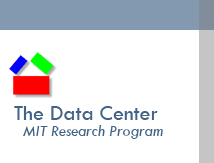


|
|
|
|
|
|
|
|
|
|
|
|
|
|
|
|
|
|
|
|
|
|
|
|
|
|
|
|
|
|
The Data Center at the Massachusetts Institute of Technology is a new initiative charged with researching and developing the languages, protocols, and technologies to integrate data and models across global networks. The Center will develop the infrastructure, recommend the standards, and build the prototype applications that enable the interoperation of data and analytic models within and across enterprises. The technologies and standards created by the Center will be open and freely distributed. What follows is an overview of the vision and goals of The Data Center. Ultimately, this work lays the foundation for a new Intelligent Information Network.
THE PROBLEM
We live in a time of unprecedented amounts of data and information. The Internet has transformed the world through the sharing of thoughts and ideas at lightening speeds. In this new world, businesses, governments, and non-profit organizations routinely manage huge amounts of data and information internally through secure computing systems.
This is only the beginning. New technologies such as radio frequency identification (RFID) and sensor networks are poised to flood organizations with even greater amounts of data and information. Corporations are currently struggling to effectively manage and integrate their legacy data systems with this new real-time data world.
The difficultly is not in the quantity or availability of data, but in the interpretation needed to make management decisions. This lies at the heart of the Data Center’s mission – to convert seemingly meaningless data into information for action.
VISION
The Data Center pictures a world of data sharing and automatic harmonization among disparate data sources. Further, this data can be combined with mathematical models to produce meaningful information for intelligent decisions. More precisely, we intend multiple, disparate databases – or portions thereof – to merge effortlessly without any a-priori agreement on content. In addition, these combined data would communicate with analytic models that provide analysis, estimates, predictions and plans. Finally, we envision models themselves would combine with other models to form larger synthetic systems.
The realization of this vision will have vast benefit to all organizations that deal with data and information – which is everyone. Although broad in scope, this vision can be achieved – albeit incrementally – by using today’s technology to provide a foundation and creating a new infrastructure to build tomorrow’s intelligent information network.
STRATEGY
Our path for achieving this vision is composed of four parts. First, we will use existing and emerging standards where possible to address near-term issues in data synchronization and sensor integration. Second, we will research and develop new languages and protocols to address fundamental problems in data and model interoperation. The “M” Language is in the early stages of being such a solution. Third, we will explore new technologies and methods to manage, analyze and visualize information and algorithms. Grid computing, immersive visualization and multi-modal user interfaces are a few of the techniques we will examine. Finally, we will test and evaluate all of these advances against real-world business concerns and practical use-cases. Taken together these elements present a multi-faceted approach to the deeper issues of data and information management, and interoperable analytic modeling.
CONCLUSION
This vision of freely interchangeable models and data is a dream we believe can be achieved – and one that stands to revolutionize the way organizations manage information. The Data Center is dedicated to researching and developing the languages, protocols and technologies needed to achieve this goal and to deliver practical solutions to industry and academia.
For more information contact Dave Brock at dlb@mit.edu
Stay informed! Receive regular updates!
Published Six Times Per Year
Copyright 2005 MIT. All Rights Reserved.